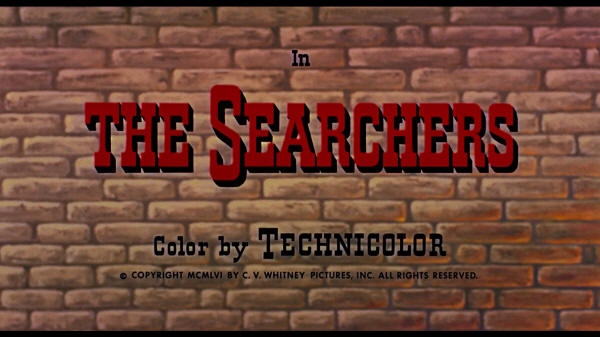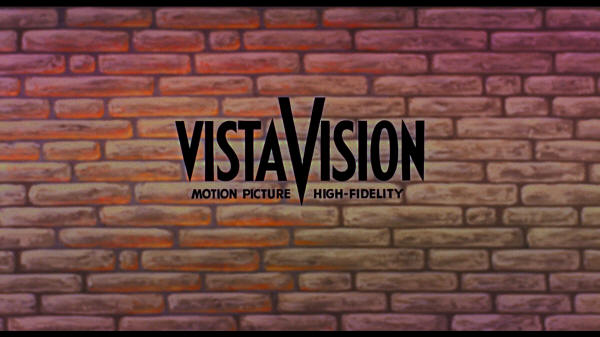"The Searchers" Restored by Warner
Brothers and Released in 70mm |
Read more at in70mm.com The 70mm Newsletter |
| Contributors to this story: Margaret Bodde, Jan Yarbrough, Miles DelHoyo, Doug Mountain, Daphne Dentz. Special thanks to: David Mortimer & Christopher Reyna. | Date: 15.04.2024 |
 Bill
Gold's original art work for the 1-sheet poster for "The Searchers"
(as seen on Wikipedia) Bill
Gold's original art work for the 1-sheet poster for "The Searchers"
(as seen on Wikipedia)World Premiere. Egyptian Theatre, Hollywood, USA. Sunday, April 21, 2024. 3:15 pm - 5:30 pm, 119m, 70mm World premiere restoration courtesy of Warner Bros. Classics. Restored by Warner Bros. in collaboration with the Film Foundation. Thomas Hauerslev, in70mm.com: Tell me about the new restoration of John Ford’s “The Searchers” – how did it come about? Margaret Bodde, Managing Director, and Daphne Dentz, SVP Mastering WBD: There’s a multi-year collaboration with The Film Foundation and TCM to remaster and restore classic films from WBD’s rich library. Robyn Sklaren, SVP of Sales Planning, Library Management and Daphne Dentz, SVP Mastering manage this process with Margaret Bodde, Executive Director and Jennifer Ahn, Managing Director from The Film Foundation. As we discussed plans for 2024, Margaret mentioned the board’s interest in "The Searchers" given the ability to scan VistaVision and we started exploring the possibility of full scale 6k restoration that included a 70mm print. • Go to "The Searchers" VistaVision Scan Samples • Go to “The Searchers”: The 70mm Presentations THa: In what condition did you find the negatives and sound elements - Were they mint condition / faded / deteriorated / shrunken? Jan Yarbrough, Senior Colorist: The Vistavision Original Camera Negative was in good condition as far as physical damage. Two issues we commonly run into with restoration projects are film shrinkage (which makes it difficult to scan the film); and color dye instability, especially in blue/yellow color layers. The OCN suffered from both of these. The abnormal amount of shrinkage made it hard to keep a stable image, while all of the color layers suffered from dye fading with the blue/yellow layer being extremely bad. In some shots the layer was so faded that the color was missing entirely. To solve this issue, it was decided to scan the blue separation master and use it to replace the OCN blue/yellow layer. (Separation masters are separate monochrome film images that represent the luminance values of the red green blue primary colors in the image). Image registration of the new blue channel proved difficult due to the differences in shrinkage between the OCN (red & green) and the Sep Master (blue). Color dye instability also caused a great amount of image flicker which we corrected for. THa: What was the most significant challenges during this restoration - considering 8-perf film, hardware to view, scan and run the prints? Jan Yarbrough, Senior Colorist: Using two very different film sources (OCN & Seps) made it difficult to get an even balance of color between skin tones and the natural beauty of the exterior desert. THa: Can you explain the scanning process of the original VV negatives? Miles DelHoyo, WBD Mastering Supervisor: The 4K restoration of John Ford’s 1956 film, "The Searchers", was sourced from a scan of the original camera negative (OCN) which is in the 8 perf 35mm VistaVision format. The full frame scanning resolution was ~13K (horizontal) which was made by scanning each frame in half (4 perf) at 6.5K and then digitally stitching the two halves together to create the full VistaVision original frame. |
More in 70mm reading: in70mm.com's page about VistaVision "The Searchers" - 70mm Screening at the Aero, Santa Monica, CA, USA "The Searchers" VistaVision Scan Samples “The Searchers”: The 70mm Presentations "North By Northwest" in 70mm at the Tribeca Festival 70mm Blow Up List 2024 - by in70mm.com "The Negative" - VistaVision Strikes Back The Making of ‘Ellston Bay’ Horizontal VistaVision Projector Berg der Kinoträume: Paramounts VistaVision “In VistaVision, Technicolor and Perspecta sound” 6-7 Juni 2009 Restoration of "Vertigo" Theo Gluck - A Master Class in Film Restoration Die Cinerama-Archäologen The Cinerama Archaeologists in70mm.com's Library Presented on the big screen in 7OMM Peripheral Vision, Scopes, Dimensions and Panoramas |
 "The
Searchers" main title card. Compressed JPEG of the final result. Courtesy:
Warner Bros. Motion Picture
Imaging. "The
Searchers" main title card. Compressed JPEG of the final result. Courtesy:
Warner Bros. Motion Picture
Imaging.THa: Any parts missing from the film and what were the surprises - scenes or soundtrack – alternate takes, missing pieces or titles, any need for B/W separations? Jan Yarbrough, Senior Colorist: In the process of replacing the blue channel with the blue sep, we discovered that approx. 11:35 into reel 01 the sep was off by a perforation for one shot, which shifted the image horizontally. The design of the set background makes it difficult to notice, so this error is in the previous video master. It’s fixed in the new master. THa: What kind of work did the soundtrack require – remixing to stereo and perhaps re-recording foley, sound and music? How is the new soundtrack created- mono/stereo/6-track DTS- were Max Steiner’s orchestral recording sessions available? Doug Mountain, Sound Supervisor / Mixer: A full forensic cleanup of all pops, ticks, and dropouts was done. The overall noise was also reduced to make the dialog more present. Some missing sound effects were added back in. When John Wayne cocks his gun during the shootout with Indians across the river the sound of the gun was missing. The rumble of the wind on the boom mic was removed or reduced on the exterior scenes to better understand the dialog. It was a mono original restored from a composition source in mono. No stems were available to remix from, and for this film it was deemed unnecessary to deviate from the original monaural presentation. The original monaural audio mix has also been restored from the best available sources, resulting in a clean and clear sound presentation for today’s digital theater systems. The original music was not available so only the mono composite mix was restored. |
|
 "The
Searchers" VistaVision title card. Compressed JPEG of the final result.
Courtesy: Warner Bros.
Motion Picture Imaging. "The
Searchers" VistaVision title card. Compressed JPEG of the final result.
Courtesy: Warner Bros.
Motion Picture Imaging.THa: How does it look in 70mm / 4k digital compared to the original release? Jan Yarbrough, Senior Colorist, and Daphne Dentz, SVP Mastering WBD: The HDR and 70mm versions each reveal more detail than audiences would have seen in the original release, which would have involved printing in 35mm from optical duplicate negatives made from the VistaVision source. Working directly from the original camera negative posed challenges due to some inherent limitations in the source photography and offered abundant opportunities to breathe new life into the imagery. The 70mm version, limited to what can be reproduced in a film pipeline, is arguably closer to what audiences in 1956 would have seen on screen, minus all the artifacts associated with the lab processes and duplicating stocks of the era. The HDR version is simply breathtaking. THa: How are the old and new film elements stored? (also stored at United States Library of Congress since 1989)? Daphne Dentz, SVP Mastering WBD: Film is held at WBD controlled vaults including on the Burbank lot. SEPS geographically are separated from OCN and held at an offsite vault across the country. New film will be vaulted at appropriate WBD vault based on asset type. THa: Can you explain how the 70mm prints were made - digital output - keeping the full AR (1,85:1 or 1,66:1) of "The Searchers" inside pillar boxed 70mm (like "Vertigo")? Daphne Dentz, SVP Mastering WBD: The 1.85:1 projection aperture image was placed within the 2.2:1 70mm/5 perf projection aperture, preserving the full image on screen, pillar boxed in the same way that other recent 1.85 70mm titles have been handled in the past. The source files were P3 6K and filmed out at FotoKem. Audio encoding and DTS track negative were handled by Inventure Studios. |
|
 "The
Searchers" John Wayne. Compressed JPEG of the final result. Courtesy:
Warner Bros. Motion Picture
Imaging. "The
Searchers" John Wayne. Compressed JPEG of the final result. Courtesy:
Warner Bros. Motion Picture
Imaging.THa: Will 70mm prints be available for exhibition at 70mm cinemas in Europe? We will be making the 70mm available to exhibition in North America, with plans to roll out to International markets. THa: Will "The Searchers" be released for home viewing on 4K disc? No release planned just yet. THa: Are there any frame scans of before and after positive and negatives available for publication? We will create a before and after demo at a later date. THa: Is there any official press available about the restoration, production info, a new poster lay out etc? Not just yet other than the TCM Film Festival announcement. |
|
Restoration Credits |
|
|
• Restoration completed by: WBD Post Production Creative Services (Motion Picture Imaging and WB Sound Burbank). • Picture Restoration Facility: WB Motion Picture Imaging. • Senior Colorist: Jan Yarbrough. • Sound Supervisor/Mixer: Doug Mountain. • Finished Picture Formats: 4k UHD HDR, Digital Cinema & 70mm prints. • Finished Sound Format: Monaural. • WBD Mastering Supervisor: Miles DelHoyo. • Project Timeline: October 2023 – March 2024 |
|
About "The Searchers"
|
|
|
The Searchers is a 1956 American epic Western film directed by John Ford and written by Frank S. Nugent, based on the 1954 novel by Alan Le May. It is set during the Texas–Indian wars, and stars John Wayne as a middle-aged Civil War veteran who spends years looking for his abducted niece (Natalie Wood), accompanied by his adopted nephew (Jeffrey Hunter). It was shot in VistaVision on Eastmancolor negative with processing and prints by Technicolor. The film was a critical and commercial success. Since its release, it has come to be considered a masterpiece and one of the greatest and most influential films ever made. It was named the greatest American Western by the American Film Institute in 2008, and it placed 12th on the same organization's 2007 list of the 100 greatest American movies of all time. Entertainment Weekly also named it the best Western. The British Film Institute's Sight & Sound magazine ranked it as the seventh-best film of all time based on a 2012 international survey of film critics and in 2008, the French magazine Cahiers du Cinéma ranked "The Searchers" number 10 in their list of the 100 best films ever made. In 1989, "The Searchers" was deemed "culturally, historically, or aesthetically significant" by the United States Library of Congress, and selected for preservation in its National Film Registry; it was one of the first 25 films selected for the registry. |
|
 • Go to "The Searchers" Restored and Released in 70mm • Go to "The Searchers" VistaVision Scan Examples |
|
| Go: back - top -
back issues -
news index Updated 22-01-25 |
